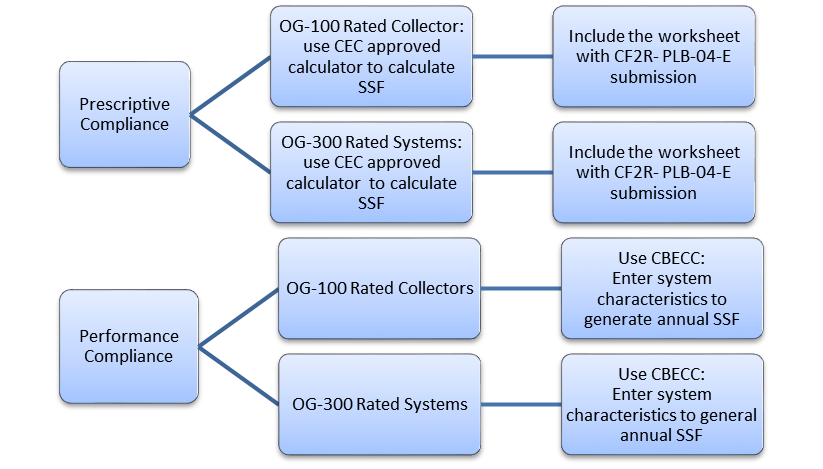
The water heating calculation method allows water heating credits for solar water heaters. Solar thermal systems save energy by using renewable resources to offset the use of conventional energy sources.
For single-dwelling solar thermal systems, systems must be Solar Rating and Certification Corporation (SRCC) approved. Accepted testing procedures include either a fully approved system with OG-300 test results or a built up system that uses the collector (OG-100) rating. For multifamily buildings, only systems with OG-100 collectors can be installed. For more detailed instructions on installation of solar water heaters, refer to Reference Appendix RA4.4.21. The sortable database of SRCC-certified equipment is located on the SRCC website at the following link:
https://secure.solar-rating.org/Certification/Ratings/RatingsSummaryPage.aspx
Figure 5-14 summarizes the process flow for demonstrating compliance via the prescriptive and performance approaches for solar thermal systems.

Regardless of the system type installed and compliance method chosen, mandatory requirements for pipe insulation apply as described in Section 5.3.5.1.
Low-rise residential buildings constructed by the State of California shall have solar water heating systems. The solar system shall be sized and designed to provide at least 60 percent of the energy needed for service water heating from site solar energy or recovered energy. There is an exception when buildings for which the state architect determines that service water heating is economically or physically infeasible. See the Compliance Options section below for more information about solar water heating systems.
5.9.1.1 Solar-Ready Buildings Requirements
There are mandatory requirements for all buildings to be “solar ready.” The motivation behind having solar-ready requirements is to encourage more future installations of both photovoltaic and solar water-heating systems, even if these systems are not installed during the time of new construction. Details on these solar ready requirements are in Chapter 7 − “Solar Ready Requirements” of this compliance manual. In summary, the elements to being solar-ready include:
•A designated solar zone.
•Designated conduit and plumbing paths.
•Documentation for solar zone and paths on construction plans.
•Adequate electric busbar and panel capacity.
This section discusses when solar water heating is required prescriptively for systems serving multiple-dwelling units.
5.9.2.1 Multifamily, Motel/Hotels, and High-Rise Nonresidential
Solar water heating is prescriptively required for water heating systems serving multiple dwelling units, whether they are multifamily, motel/hotels, or high-rise nonresidential buildings. The minimum solar fraction depends on the climate zone (CZ): 0.20 for CZ 1 through 9 and 0.35 for CZ 10 through 16. See Table 5-11 below.
|
Climate Zone |
Minimum Solar Fraction |
|
1-9 |
0.20 |
|
10-16 |
0.35 |
The regulations do not limit the solar water heating equipment or system type as long as they are SRCC-certified and meet the orientation, tilt, and shading requirement specified in Reference Appendix RA4.4. Installation of a solar water heating system exempts multifamily buildings from needing to set aside solar zone for future solar PV and solar water heating installation as specified in §110.10(b)1B). The following paragraphs offer some high-level design considerations for multifamily building solar water heating systems.
A high-priority factor for solar water heating system design is component sizing. Proper sizing of the solar collectors and solar tank ensures that the system takes full advantage of the sun’s energy while avoiding the problem of overheating. While the issue of freeze protection has been widely explored (development of various solar water heating system types is a reflection of this evolution), the issue of overheating is often not considered as serious as it should be, especially for climate conditions with relatively high solar insolation level such as California. This is especially critical for multifamily-sized systems, due to load variability.
The solar water heating sizing requirements for the standards are conservative. For example, the highest solar fraction requirement in the 2013 Energy Standards was at 50 percent. Stakeholders further suggested that industry standard sizing for an active system is 1.5 square feet of collector area per gallon capacity of the solar storage tank. For more detailed guidance and best practices, there are many publicly available industry design guidelines. Two such resources developed by/in association with government agencies are:
1. Building America Best Practices Series: Solar Thermal and Photovoltaic Systems http://apps1.eere.energy.gov/buildings/publications/pdfs/building_america/41085.pdf.
2. California Solar Initiative – Thermal: Program Handbook http://www.cpuc.ca.gov/NR/rdonlyres/CB11B92E-DFFF-477B-BFA9-F1F04906F9F9/0/CSIThermal_Handbook201209.pdf.
Because of the solar water heating requirements and the prevalence of recirculation hot water systems in multifamily buildings, it is essential to emphasize the importance of proper integration between the hot water recirculation system and the solar water heating system. Industry stakeholders recommended the recirculation hot water return to be connected back to the system downstream of the solar storage tank. This eliminates the unnecessary wasted energy used to heat up water routed back from the recirculation loop that may have been sitting in the solar water tank if no draw has occurred over a prolonged period.
Another design consideration is the layout and placement of collectors and solar tank. The idea here, similar to the discussions on recirculation system design in Section 5.6 is to minimize the length of plumbing, thus reducing pipe surface areas susceptible to heat loss and piping materials needed. This calls for the shortest feasible distance between the collectors themselves; furthermore, since solar tanks are typically plumbed in series just upstream of the conventional/auxiliary water heating equipment, the distance between collectors and solar tank should also be as short as possible.
Solar water heating systems with a solar fraction higher than the specified prescriptive minimum can be used as a tradeoff under the performance approach. Figure 5-13 shows the compliance process needed for demonstrating compliance with solar water heating modeling. The CBECC-Res API integrates the capability of calculating an annual solar fraction. Users now input collector and system component specifications to calculate a corresponding solar fraction for the proposed system.